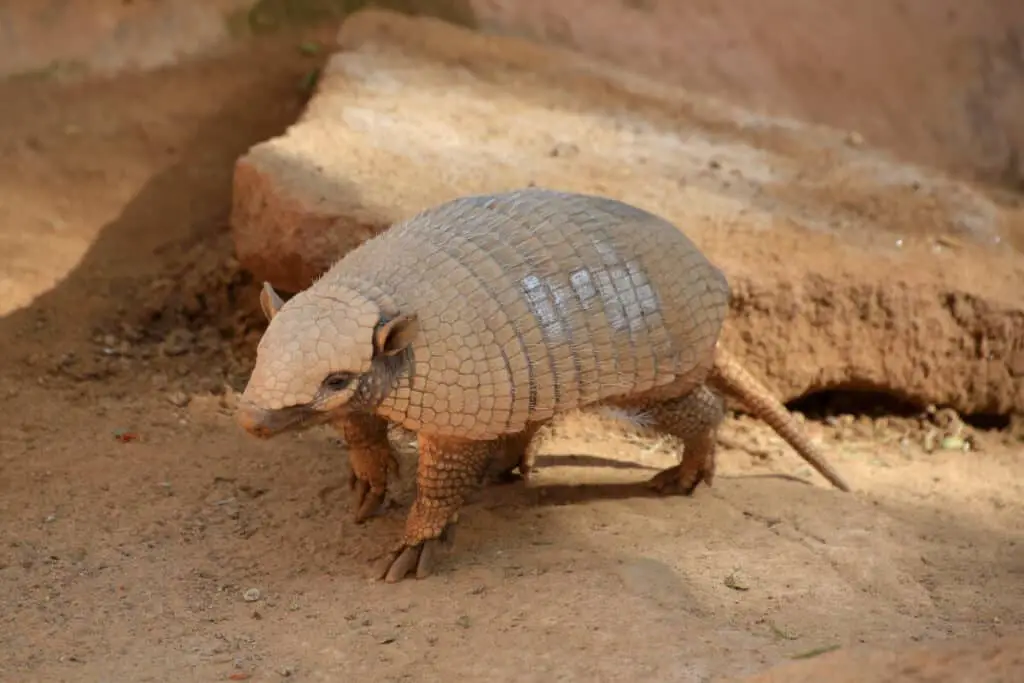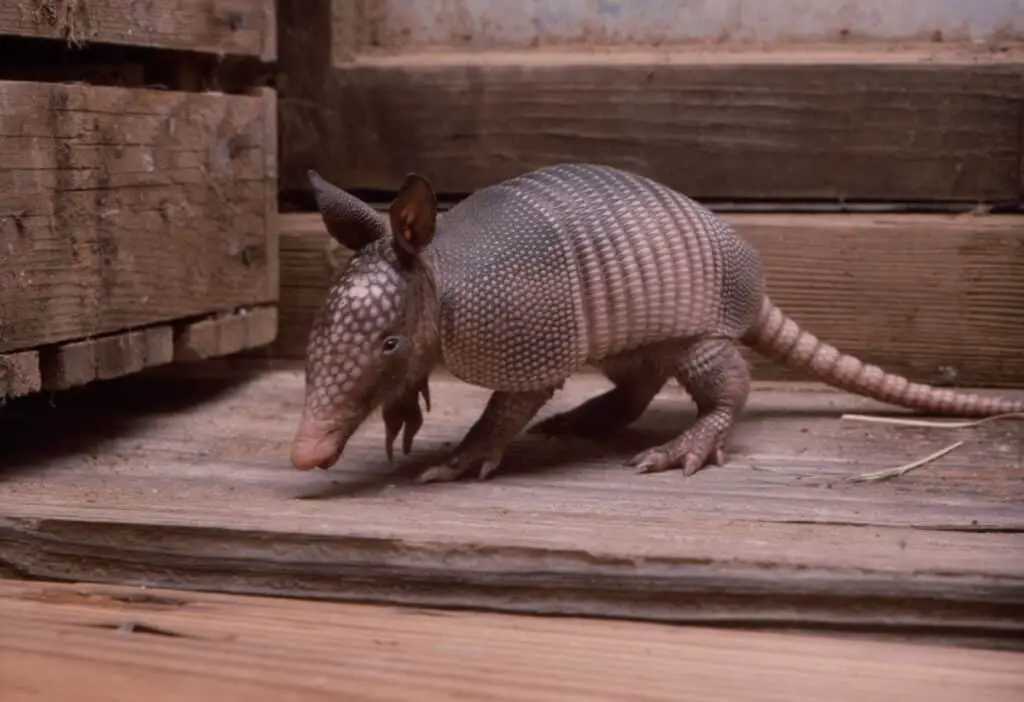The armadillo is an interesting mammal found in many parts of the world, with a distinctive shell and behavior. It has adapted to numerous habitats over its long evolution, which makes it an important topic for study.
This article will explore where armadillos live, what climates they prefer and how this impacts their populations around the globe.
Armadillos are found naturally living in tropical regions throughout Central America, South America and Mexico. They have also been introduced into some areas outside of their natural range due to human activity, such as Florida in the United States and certain parts of Europe.
These introductions can lead to drastic changes in local ecosystems that must be taken into account when studying the armadillo’s ecology.

Geographic Range Of Armadillos
Armadillos are small, burrowing mammals that have long been a fixture of the American South. Characterized by their protective armor-like shells and lumbering gait, these creatures occupy an area stretching from Argentina in South America to northern Mexico. Their altering range due to migration patterns has seen them spread further north than ever before, with sightings now occurring as far up as Kansas and Missouri.
Armadillos are native to the Americas and are primarily found in regions with warm climates. They inhabit a variety of habitats ranging from grasslands to forests.
| Armadillo Species | Native Range |
|---|---|
| Nine-banded Armadillo | North, Central, and South America |
| Giant Armadillo | Central and South America |
| Southern Three-banded | Argentina, Bolivia, Brazil, and Paraguay |
| Six-banded Armadillo | Brazil, Bolivia, Paraguay, and northern Argentina |
| Seven-banded Armadillo | Brazil, Paraguay, and northeastern Argentina |
| Pink Fairy Armadillo | Argentina |
Please note that the ranges provided are general and armadillo species may have localized distributions within these regions.
The most common species found in the United States is the nine-banded armadillo, which is also known for its remarkable ability to jump several feet into the air when alarmed or startled. Though they are hardy animals that can survive in extreme temperatures, armadillos prefer warm climates and generally inhabit open grasslands, marshes, prairies, savannas and forests.
They often build burrows near ponds or streams where there is plenty of vegetation to feed on, such as insects and fruits like wild berries.
Armadillos In The United States
Armadillos are found in the wild all over North, Central and South America. In the United States, they range from Texas to Georgia and as far north as Nebraska.
Nine-banded armadillos have adapted well in many areas of their range, coexisting with humans and other animals while still maintaining a relatively solitary life. When alarmed, nine-banded armadillos can jump 3–4 feet into the air or dig rapidly into soil that is soft enough for them to burrow through. When threatened by predators like coyotes, foxes and bobcats, these armadillos may flee quickly into a nearby den or bury themselves in shallow soil until danger passes.
They usually prefer to avoid confrontations but will use their sharp claws if necessary. Armadillo behavior varies between species; some are more active during the day while others come out at night.
Habitats Preferred By Armadillos
Armadillos are small mammals that live in Central and South America, as well as parts of the United States. They prefer to inhabit open areas with loose soil, such as savannas, grasslands, and wooded regions.
Armadillos have a distinct burrowing behavior which allows them to create dens where they can stay safe from predators. When building their homes, armadillos look for soils that are moist and soft but also firm enough to support the walls of their tunnels. These animals are capable of digging deep underground; some species can even reach depths up to two meters below ground level!
The ideal soil conditions for armadillo burrows include sandy loam or clay-loam soils with high moisture content. It is important for the den structure to remain stable since the stability of its inhabitants depends on it.
In addition to creating secure living spaces, these burrows allow armadillos to regulate their body temperatures more efficiently by taking advantage of the cool air located beneath the surface. Furthermore, when needed, armadillos will use existing cavities instead of making new ones if available in order to save energy and time spent on excavation.
How Habitats Affect Armadillo Populations
Armadillos are found in a variety of habitats across the Americas, from woodlands and grasslands to deserts. The most common species, the nine-banded armadillo, is especially adept at adapting its habitat needs to fit different ecological regions.
Each type of habitat offers different benefits for an armadillo population:
- Woodland habitats provide plenty of food sources through insects and plants as well as places to hide during hunting periods.
- Grassland habitats offer more open space that allows for easier movement between burrows and nesting sites, which is essential for their dietary needs.
- Deserts offer fewer predators than other habitats due to low vegetation cover and extreme temperatures, allowing armadillos greater freedom to explore their environment safely.
- Wetlands provide ample water resources while also offering protection against predators due to dense vegetation cover.
The successful survival of an armadillo population depends on its ability to take advantage of all these features while also relying on its burrowing habits as a defense mechanism against any potential threats. As such, it is crucial for conservation efforts aimed at protecting this species to understand how each type of habitat affects the overall health and wellbeing of an armadillo population.
Human Impact On Armadillo Populations
The relationship between habitats and armadillo populations is complex, with human activities often having a significant impact.
Urban development, agricultural practices, and other forms of land use threaten to reduce the amount of suitable habitat for these animals. This can lead to changes in their distributions and numbers as they struggle to find enough food or places where they feel safe from predators.
Human-induced environmental change has had far-reaching effects on armadillos across the globe.
In some areas, urban sprawl has led to reduced access to natural resources such as insects and plants that form part of their diet while fragmenting existing habitat into smaller patches which may no longer be viable for them because of increased predation risk.
Agricultural practices have also caused direct harm by reducing available space for burrowing or denning sites through soil compaction and deforestation.
Additionally, pesticides used in farming can result in contaminated soils leading to toxic exposures affecting reproduction or behavior of these creatures.

Conserving Armadillo Populations
Armadillos are found in a variety of habitats throughout Central and South America. Their ability to adapt and survive in different environments has enabled them to thrive, but they now face some significant threats from human activity.
In order to ensure the survival of armadillo populations across their range, conservation efforts must be undertaken. Conservationists have identified several key actions that should form part of an effective strategy for conserving armadillo populations.
Firstly, managing resources such as water and food is essential for providing suitable habitat conditions where these species can live successfully. Secondly, addressing climate changes through emissions reductions, restoring forests and other natural ecosystems, and reducing agricultural expansion into wild areas could help reduce the pressure on existing armadillo populations.
Additionally, efforts should also focus on preventing poaching activities by introducing tougher penalties for wildlife trafficking and illegal hunting. Finally, engaging with local communities to raise awareness about the importance of preserving wildlife will go a long way towards protecting armadillos from potential harm or exploitation.
These measures need to be implemented urgently if we want to secure the future of this remarkable animal species. By taking action now we can prevent further loss of biodiversity due to unsustainable practices which threaten not only armadillos but many other species too.
Conclusion
The geographic range of armadillos is vast, ranging from the United States to South America.
In the U.S., they inhabit areas such as deserts and grasslands, while in other parts of their range they may be found in tropical rainforests or dry scrub forests.
Generally speaking, armadillos prefer open habitats with access to plenty of food sources and shelter.
It is important that these conditions remain suitable for them in order to maintain healthy populations; unfortunately human activity can often have a negative impact on their habitats and thus limit the number of individuals able to survive.
To ensure future generations of armadillos are allowed to thrive, conservation efforts should focus on protecting existing habitat and creating new ones where necessary; this way we can safely say ‘the only place an armadillo won’t live is somewhere it’s not wanted’.

